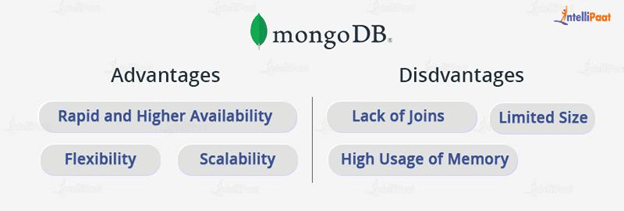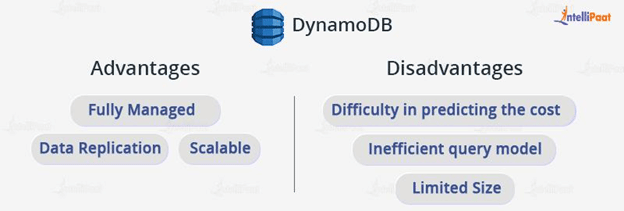Dynamodb Vs Mongodb – Know The Difference
Many apps and services use databases as a fundamental part of their architecture. MongoDB and DynamoDB are two highly popular NoSQL databases opted for by developers. They are flexible and capable of storing large amounts of data.
Follow along as we gain in-depth knowledge about these innovative technologies.
Points at a Glance
- What is MongoDB?
- What is DynamoDB?
- Difference between SQL and NoSQL
- DynamoDB VS MongoDB
- Advantages and Disadvantages of MongoDB
- Advantages and Disadvantages of DynamoDB
- Which to choose: MongoDB or DynamoDB?
- Conclusion
To make learning easier and understand MongoDB in detail, watch this Tutorial that covers the complete course on MongoDB
Before we get to the differences between MongoDB VS DynamoDB, let’s first understand what each of these terms stands for.
What is MongoDB?

MongoDB was launched in 2009. It is a NoSQL database solution that is open-source in nature.
The document model is MongoDB’s main distinguishing feature.
- In MongoDB, data can be stored by users in the records, named as documents.
- MongoDB solves a huge problem for developers. Where earlier they had to build their applications to accommodate the needs or requirements of the database, they can now simply modify or add new data whenever they want without worrying about ruining everything.
- It can efficiently scale across several different servers to store and process data. This is a great technique for the cloud because using this technique data can be spread and stored on various different machines.
- MongoDB saves developers from spending huge amounts of money on upgrading mainframes as they can expand the data by simply adding more servers.
- A database in MongoDB is not formed unless it has content!
Now that we understand MongoDB, let’s quickly understand what DynamoDB is.
What is DynamoDB?

Things like Web gaming and Ad Tech usually overburden relational database models. To overcome this issue, a new NoSQL database, known as DynamoDB was launched in 2012.
- As its name states, the data stored in DynamoDB is dynamic. It is extremely easy to modify it as and when required.
- It is a fast, flexible, and consistent solution offered and maintained by AWS(Amazon Web Services).
- It is a key-value database. This entails that to create a table in the database, there is no need for a schema, only a primary key is required.
- DynamoDB offers unlimited storage and seamless scaling.
- It works on a Pay-per-use pricing model.
- It keeps the data encrypted even at rest, i.e., even when a particular table is not in use, it remains encrypted and therefore more secure.
MongoDB and DynamoDB both are NoSQL databases.
So prior to learning what are the differences between them, it is important to understand SQL and NoSQL.
Difference between SQL and NoSQL
SQL is considered the parent language for databases. Although the classic model of a database is capable of providing consistency, it is not always able to scale large amounts of data. Therefore, to make this process more efficient NoSQL database came into existence.
Here’s a quick differentiation between SQL and NoSQL to help you understand better.
SQL(Structured Query Language):
- It is used in a relational database system.
- The schemas in SQL are static.
- SQL databases can be used to solve complex queries.
- An SQL database is vertically scalable.
- SQL follows ACID properties. (ACID: Atomicity, Consistency, Isolation, and Durability).
NoSQL(Not Only SQL):
- It is used for a non-relational database system.
- The schemas in NoSQL are dynamic.
- NoSQL databases can not be used to solve complex queries.
- A NoSQL database is horizontally scalable.
- NoSQL follows CAP. (CAP: Consistency, Availability, and Partition Tolerance).
Want to learn SQL from scratch?? Enroll in this exclusive Certification Training Course to gain in-depth knowledge of the topic! Microsoft SQL Certification Training
Okay, now that we are aware of the difference between SQL and NoSQL databases, it’s finally time to look into the things that differentiate MongoDB from DynamoDB.
DynamoDB VS MongoDB
DynamoDB
- Out-of-the-box security is provided by DynamoDB. It is possible to securely manage access to AWS services and resources owing to the security model’s Identity and Access Management (IAM) foundation.
- The indexes in DynamoDB are immutable.
- In DynamoDB, the document size is restricted to 400KB.
- Where MongoDB can be configured, run, and deployed anywhere, DynamoDB can only be configured and used through Amazon Web Services (AWS).
- DynamoDB is fully managed, i.e., it is managed completely by AWS.
- The pricing in the case of DynamoDB is throughput based.
Career Transition
MongoDB
- Although MongoDB is secure, it does not provide out-of-the-box security and therefore can be vulnerable to breaches.
- The indexes in MongoDB are mutable.
- 16MB is the limit of the document size in MongoDB.
- Using MongoDB, users have the freedom to store, configure, or run databases from anywhere in the world.
- In the case of MongoDB, users need to manage the configurations and infrastructure of the database by themselves.
- There is consistent pricing when it comes to MongoDB. It is based on storage, RAM, or I/O.
Have a look at the advantages as well as disadvantages of MongoDB to have a better understanding of the same.
Advantages and Disadvantages of MongoDB

ADVANTAGES:
- Rapid and Higher Availability-
MongoDB works in a much faster way as compared to other relational databases. In addition, it allows easier access to data with higher availability, due to its document-based model.
- Flexibility-
In MongoDB, the schemas are dynamic in nature. This means that data can be changed or added at any time from anywhere.
- Scalability-
In the case of MongoDB, the concept of sharding is used, due to which the storage capacity can be expanded. In contrast to other SQL databases, MongoDB thus allows horizontal scalability.
DISADVANTAGES:
- Lack of Joins-
Unlike other relational databases, the joining of documents in MongoDB can be extremely complicated:
This is because it does not support the joins functionality. This functionality can be added manually by coding it, but it will eventually result in higher consumption of time, consequently affecting the performance.
- High Usage of Memory-
MongoDB makes use of a lot of memory. Due to its lack of Joins functionality, data duplication takes place which then leads to data redundancy. This causes a huge amount of storage space to be used up.
- Limited Size-
The document size in MongoDB is limited to 16MB only. In addition to that, the limit when it comes to the performance nesting of documents is only up to 100 levels.
We’ve seen the advantages and disadvantages of MongoDB, but what about DynamoDB? What are its pros and cons?
Let’s see…
Advantages and Disadvantages of DynamoDB

ADVANTAGES:
- Fully Managed-
DynamoDB is a fully managed database provided by AWS (Amazon Web Services). Users of DynamoDB don’t have to worry about its configuration, setup, and maintenance, as all these tasks are handled by AWS itself. This enables users to focus more on developing applications without wasting their time.
- Data Replication-
DynamoDB replicates table data over three availability zones in a single region. Due to this, recovery from any disaster is easy without causing service disruptions.
Moreover, the data can be replicated across multiple different locations by using DynamoDB global tables. This results in higher levels of redundancy and thus minimum data loss.
- Scalable-
Unlimited virtual storage is provided to the users by DynamoDB. Additionally, it gives developers the freedom to extend the database only when the application begins to gather data rather than right away. Therefore, when deploying the database, reserve storage is not required.
Courses you may like
DISADVANTAGES:
- Difficulty in predicting the cost-
Depending on the use case, DynamoDB gives customers the option to choose a suitable capacity allocation technique.
Although the on-demand approach’s flexibility enables seamless expansion, one of the major disadvantages of employing this strategy is its unpredictability and high costs.
- Limited Size-
There can be a maximum of 10 items and 400KB is the size limit for an item in DynamoDB.
- Inefficient query model-
DynamoDB provides limited querying options. If there are no indexes, there won’t be any querying allowed. To query the data, the users have the option of scanning the entire table. But this is an extremely tedious task to complete, let alone an expensive one.
Alright, now we know everything about MongoDB and DYnamoDB.
So, now the most important question: Which of them is better??..
Which to choose: MongoDB or DynamoDB?

Both MongoDB and DynamoDB are amazing technologies. Deciding which of these to choose solely depends on a case-to-case basis. It is not about which is better of the two but about which provides the features that are required for your specific project or use case.
However, it is equally important to be careful when selecting one. Factors such as user requirements, scale, functionality, and deployment play an important role in this process.
Here are a few points to keep in mind that can aid you in making your decision:
DynamoDB is the right fit for you if,
- Your present need is managing and deploying applications using the AWS echo system.
- You want a database that can support simple key-value workloads.
- You do not want to deal with a lot of security configurations. AWS will manage them on its own.
- You want to implement only a small subset of programming languages: Java, Nodes.js, JavaScript, PHP, .NET, Swift, and Python.
On the other hand,
MongoDB is the right fit for you if,
- You require a database that offers flexibility in deployment and supports a significantly wider range of use cases.
- You want a comparatively better query performance.
- You want a technology that supports almost all the existing programming languages.
- You want an open-source solution that is transparent and can be run from anywhere at any time.
Here is a list of popular MongoDB Questions and answers, framed by our Industry experts, to help you prepare for your interview. Top MongoDB Interview Questions and Answers.
Conclusion
The database is considered the backbone of today’s data-driven industry. DynamoDB and MongoDB are two emerging NoSQL-based database services that are successfully replacing other traditional database systems.
No matter which of the two technologies you opt for, both of them have their own benefits and are likely to succeed.
Still having doubts? No worries! Drop your queries on our Community Page and we’ll help you get through them!
The post Dynamodb Vs Mongodb – Know The Difference appeared first on Intellipaat Blog.
Blog: Intellipaat - Blog
Leave a Comment
You must be logged in to post a comment.













